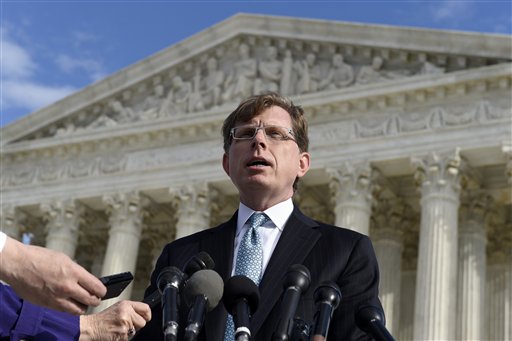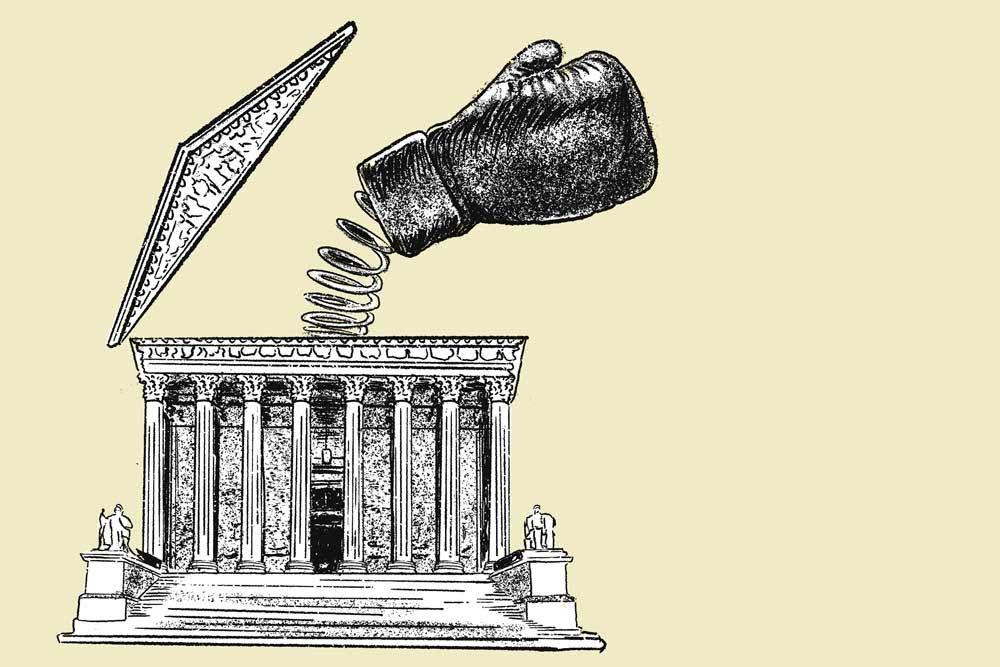Elonis v. United States (2015) – Threats – 1st Amendment
In Elonis v. United States 575 US __ (2015), Chief Justice John G. Roberts, Jr. was joined by six justices who reversed a trial court conviction, which had been upheld by the 3rd U.S. Circuit Court of Appeals. They decided that Anthony Douglas Elonis had been improperly convicted of transmitting threats through postings on Facebook.
Elonis posted lyrics that appeared to be threatening but had disclaimers

Elonis had posted rap lyrics under the name of “Tone Dougie” that appeared to threaten his ex-wife, an FBI agent, and even a kindergarten class. However, he had included disclaimers indicating that his lyrics were “fictitious,” that they were “therapeutic,” that they emulated the lyrics of rap star Eminem, and that they were a proper exercise of Elonis’ First Amendment rights.
Trial court used ‘reasonable person’ standard to convict Elonis
At trial, Elonis requested the judge to instruct the jury that to convict him, the government must prove that he intended to convey a true threat. Instead, the court instructed jurors that they need only find that “a reasonable person” would interpret the words to constitute such a threat.
‘Reasonable person’ lowers standard for criminal conviction to negligence
Although the federal statute (18 USC Sec. 875 (c)) under which Elonis was convicted does not specify an individual’s requisite mental state, the Court has long insisted that “wrongdoing must be conscious to be criminal.” This is because criminal law has always insisted on actual blameworthiness as expressed in such terms as “mens rea, scienter, malice aforethought, guilty knowledge and the like.” A criminal defendant must “know the facts that make his conduct fit the definition of the offense.”
The reasonable person standard that the lower court employed effectively reduces the standard for a criminal conviction to that of negligence, which is more consistent with the standard for civil liability. Hamling v. United States (1974) established that individuals would not necessarily have to know whether materials they distributed were legally obscene to be convicted, but they would have to know “the character of what was sent.”
Although Elonis asserted that recklessness was not sufficient to show that he had uttered a true threat, neither he nor the government briefed this issue, and there were no conflicting circuit court opinions on the subject that the Court might review. The Supreme Court accordingly refused to decide whether a showing of recklessness would prove to be legally sufficient for such a criminal conviction.
Court overturned conviction
In a partial concurrence and a partial dissent, Justice Samuel Alito agreed that the Court appropriately sought to show that Elonis had mens rea but thought that an instruction requiring proof of recklessness would be sufficient to show this. Alito stressed that the First Amendment does not protect true threats, which “inflict great harm and have little if any social value.”
Despite Elonis’ reliance on professional performers who used similar lyrics, Alito observed that “’[t]aken in context,’ lyrics in songs that are performed for an audience or sold in recorded form are unlikely to be interpreted as a real threat to a real person.” Alito would accordingly remand the case to the court of appeals to decide “whether Elonis’ conviction could be upheld under a recklessness standard” and whether, alternatively, the instructions might be regardless as “harmless error.”
Dissenters pointed out that true threats are not protected by the First Amendment
In a dissenting opinion, Justice Clarence Thomas observed that nine of 11 circuits that had interpreted the statute had found that it required a showing of general intent. Thomas further thought that Elonis’s words met the objective standard for a true threat.
Elonis’ own belief about the legal status of his words is immaterial, Thomas said. Thomas denied that a showing of general intent is equivalent to a showing of mere negligence – “there is nothing absurd about punishing an individual who, with knowledge of the words he uses and their ordinary meaning in context, makes a threat.”
Both English precedents and early state laws establish that freedom of speech has never included true threats, and “[w]e generally have not required a heightened mental state under the First Amendment for historically unprotected categories of speech.” Thomas cited cases involving “fighting words” and cross burning. Elonis is just as guilty of issuing a true threat, Thomas said, as he would be had he mailed obscene materials to his wife or to the kindergarten class that he threatened.
John Vile is a professor of political science and dean of the Honors College at Middle Tennessee State University. He is co-editor of the Encyclopedia of the First Amendment. This article was originally published in 2009.
cited https://mtsu.edu/first-amendment/article/1455/elonis-v-united-states
Facts and Case Summary – Elonis v. U.S.
Read the facts of the case and follow its path to the Supreme Court.
Facts
Anthony Elonis was arrested on December 8, 2010 and charged with five counts of violating a federal anti-threat statute, 18 U.S.C. § 875(c). Specifically, he was charged with threatening his ex-wife, co-workers, a kindergarten class, the local police, and an FBI agent.
Elonis had posted statements on his Facebook page that appeared to threaten his ex-wife and other people in his life. Prior to the postings, his wife and family had left him and he had lost his job at an amusement park. Shortly after this chain of events, Elonis posted several statements on his Facebook page that were interpreted as threats.
At his trial, Elonis asked the court to dismiss the charges, stating that his Facebook comments were not true threats. He argued that he was an aspiring rap artist and that his comments were merely a form of artistic expression and a therapeutic release to help him deal with the events in his life.
In an apparent attempt to underscore that his comments should not be taken seriously, he posted links to YouTube videos that he parodied, and noted that a popular rap artist often uses similar language in his lyrics. For several of his comments, he also posted a disclaimer stating: “This is not a threat.”
Despite the fact that his ex-wife, an FBI agent, and others viewing his comments might have perceived his statements as threats, Elonis argued that he could not be convicted of making a threat because he did not intend to threaten anyone with his postings. In other words, he claimed that he didn’t mean what he said in a literal sense. In legal terms, he said that he did not have a subjective intent to threaten anyone.
The trial court denied his motion to dismiss the case. The court held that the proper legal test for determining whether someone made a threat is an objective one: whether reasonable people hearing the comment would perceive it to be a threat. Elonis was convicted of four of the five counts. He was sentenced to 44 months imprisonment, and three years of supervised release.[1] He appealed to the U.S. Court of Appeals for the Third Circuit, which affirmed his conviction. The U.S. Supreme Court, granted certiorari (agreed to hear the case). Oral arguments were heard on Monday, December 1, 2014. A decision is expected by June 2015.
[1] Please Note: After the trial, Elonis, through his lawyers, filed post-trial motions with the trial court in an attempt to overturn the conviction. These attempts also were unsuccessful.
The First Amendment Provides That
“Congress shall make no law . . . abridging the freedom of speech [.]”
Applicable Law
It is a federal crime to “transmit [ ] in interstate or foreign commerce any communication containing…any threat to injure the person of another, 18 U.S.C. § 875(c). Numerous states have adopted similar statutes.
Procedure
Lower Court 1: U.S. District Court for the Eastern District of Pennsylvania
Lower Court Ruling 1: The U.S. District Court rejected Elonis’ argument that a subjective (i.e., individual) intent to threaten is required to secure a conviction under the federal anti-threat statute.
Lower Court 2: U.S. Court of Appeals for the Third Circuit
Lower Court Ruling 2: The Court of Appeals affirmed the U.S. District Court. It held that a reasonable person (i.e., objective) standard is the correct legal test for determining whether Elonis could be convicted of communicating a threat under federal law.
Issue Before the U.S. Supreme Court
Does a conviction of threatening another person under federal anti-threat statute18 U.S.C. § 875(c) require proof that the defendant meant what he said in a literal sense?
Status
Oral Arguments: Heard at the Supreme Court of the United States on Monday, December 1, 2014.
Judgment
Reversed and remanded, 8-1, in an opinion by Chief Justice Roberts on June 1, 2015. Justice Alito filed an opinion concurring in part and dissenting in part. Justice Thomas filed a dissenting opinion.`
Elonis v. United States
Elonis v. United States, 575 U.S. 723 (2015), was a United States Supreme Court case concerning whether conviction of threatening another person over interstate lines (under 18 U.S.C. § 875(c)[1]) requires proof of subjective intent to threaten or whether it is enough to show that a “reasonable person” would regard the statement as threatening.[2] In controversy were the purported threats of violent rap lyrics written by Anthony Douglas Elonis and posted to Facebook under a pseudonym.[3] The ACLU filed an amicus brief in support of the petitioner.[2] It was the first time the Court has heard a case considering true threats and the limits of speech on social media.[4]
Background[edit]
Elonis was in the process of divorce and made a number of public Facebook posts.
He “posted the script of a sketch” by The Whitest Kids U’ Know, which originally referenced saying “I want To kill the President of the United States” and replaced the president with his wife:
Did you know that it’s illegal for me to say I want to kill my wife?
It’s illegal.
It’s indirect criminal contempt.
It’s one of the only sentences that I’m not allowed to say.
Now it was okay for me to say it right then because I was just telling you that it’s illegal for me to say I want to kill my wife…
Um, but what’s interesting is that it’s very illegal to say I really, really think someone out there should kill my wife. . . .
But not illegal to say with a mortar launcher.
Because that’s its own sentence. . . .
I also found out that it’s incredibly illegal, extremely illegal to go on Facebook and say something like the best place to fire a mortar launcher at her house would be from the cornfield behind it because of easy access to a getaway road and you’d have a clear line of sight through the sun room. . . .
Yet even more illegal to show an illustrated diagram. [Here Elonis posted an illustrated diagram]…
Elonis ended the post with this statement: “Art is about pushing limits. I’m willing to go to jail for my constitutional rights. Are you?”
A week later, Elonis posted about local law enforcement and a kindergarten class, which caught the attention of the Federal Bureau of Investigation. Then, he wrote a post on Facebook about one of the agents who visited him:
…Took all the strength I had not to turn the bitch ghost
Pull my knife, flick my wrist, and slit her throatLeave her bleedin’ from her jugular in the arms of her partner…
He concluded:
And if you really believe this s***
I’ll have some bridge rubble to sell you tomorrow
[BOOM!][BOOM!][BOOM!]
The actions led to Elonis’s indictment by a grand jury on five counts of threats to park employees and visitors, local law enforcement, his estranged wife, an FBI agent, and a kindergarten class that had been relayed through interstate communication.
At the district court, Elonis moved to dismiss the indictment for failing to allege that he had intended to threaten anyone. His motion was denied. He requested a jury instruction that “the government must prove that he intended to communicate a true threat.” which was also denied. He was convicted on the last four of the five counts, and was sentenced to 44 months in prison and three years on supervised release. He appealed unsuccessfully to the Third Circuit, renewing his challenge to the jury instructions. He then appealed to the U.S. Supreme Court based on lack of any attempt to show intent to threaten and on First Amendment rights.[3][4][5][6]
Decision[edit]
On June 1, 2015, the U.S. Supreme Court reversed Elonis’s conviction in an 8-1 decision. Chief Justice John Roberts wrote for a seven-justice majority, Samuel Alito authored an opinion concurring in part and dissenting in part, and Clarence Thomas authored a dissenting opinion. The finding of the circuit court was reversed and the matter remanded.
Majority opinion[edit]
The majority opinion, written by Roberts, did not rule on First Amendment matters or on the question of whether recklessness was sufficient mens rea to show intent. It ruled that mens rea was required to prove the commission of a crime under §875(c). Importantly, the mens rea issue had been preserved for review, since Elonis had raised that objection at every stage of the previous proceedings.
The government contended that the presence of the words “intent to extort” in §875(b) and §875(d) implied that the absence in §875(c) was constructive. The court disagreed, holding that the absence of the language in §875(c) was because the section was intended to have a broader scope than threats relating to extortion.
The opinion drew on many Supreme Court cases holding that in criminal law, mens rea was required though it had not been mentioned explicitly in statute. Consequently, the Supreme Court ruled in favor of Elonis.
Alito’s concurrence[edit]
Justice Samuel Alito, concurring in part and dissenting in part, opined that while agreeing that mens rea was required and specifically that showing negligence was not sufficient, the court should have ruled on the question of recklessness. He further opined that recklessness was sufficient to show a crime under that provision on the basis that going further would amount to amending the statute, rather than interpreting it. Since Elonis explicitly argued that recklessness was not sufficient, Alito said:
I would therefore remand for the Third Circuit to determine if Elonis’s failure (indeed, refusal) to argue for recklessness prevents reversal of his conviction.
The Third Circuit should also have the opportunity to consider whether the conviction could be upheld on harmless error grounds.
Alito also addressed the First Amendment question, elided by the majority opinion. He held that “lyrics in songs that are performed for an audience or sold in recorded form are unlikely to be interpreted as a real threat to a real person…. Statements on social media that are pointedly directed at their victims, by contrast, are much more likely to be taken seriously.”
Thomas’s dissent[edit]
Justice Clarence Thomas, dissenting, wrote against discarding the “general intent” standard without replacing it with a clearer standard. Thomas argued that “there is no historical practice requiring more than general intent when a statute regulates speech.”
Thomas cited Rosen v. United States, arguing that general intent was sufficient in this case. However, the majority opinion offers refutation in that Rosen turned on ignorance of the law: knowledge as to whether material was legally obscene, not on whether it was intended to be obscene. Thomas also supported the government’s claim that the presence of “intent to extort” language in the adjacent §875(b) and did not address the majority’s reasoning on that language.
Thomas used precedent, notably from the states and 18th-century England based on other but similar and, arguably, influencing legislation to support his “general intent” claim. Thomas also drew a parallel with general intent in tort. While he sought to address the First Amendment issues, he never strayed far from “general intent.”
Aftermath[edit]
On remand, the Third Circuit reaffirmed the conviction “conclud[ing] beyond a reasonable doubt that Elonis would have been convicted if the jury had been properly instructed” and therefore was harmless error.[7]
See also[edit]
Footnotes[edit]
- ^ .
- ^ Jump up to:a b “Elonis v. United States”. SCOTUSblog. Supreme Court of the United States. Retrieved October 6, 2014.
- ^ Jump up to:a b John, Arit (October 5, 2014). “The 8 Most Important Cases in the New Supreme Court Term”. Bloomberg Politics. Retrieved October 6, 2014.
- ^ Jump up to:a b Emily Bazelon (November 25, 2014). “Do Online Death Threats Count as Free Speech?”. The New York Times Magazine. Retrieved November 25, 2014.
- ^ “Elonis v. United States, 13-983 Respondent Brief” (PDF). American Bar Association. Retrieved November 26, 2014.
- ^ Robert Barnes (November 23, 2014). “Supreme Court case tests the limits of free speech on Facebook and other social media”. The Washington Post. Retrieved November 25, 2014.
- ^ “Case Summary: ELONIS V. UNITED STATES (2015)”. Drexel University Thomas R. Kline School of Law. Retrieved February 3, 2021.
Maryland Law Review
With volume one dating back to 1936, the Maryland Law Review is the oldest journal at the University of Maryland Francis King Carey School of Law and the pre-eminent student authority on developments in Maryland case law in the State of Maryland
Maryland Law Review Volume 75 | Issue 4 Article 7
Elonis v. United States: The Need to Uphold Individual Rights to Free Speech While Protecting Victims of Online True Threats by Alison J. BestWhich can be download in PDF Here
To Learn More…. Read MORE Below and click the links
Learn More About True Threats Here below….
We also have the The Brandenburg v. Ohio (1969) – 1st Amendment
CURRENT TEST = We also have the The ‘Brandenburg test’ for incitement to violence – 1st Amendment
We also have the The Incitement to Imminent Lawless Action Test– 1st Amendment
We also have the True Threats – Virginia v. Black is most comprehensive Supreme Court definition – 1st Amendment
We also have the Watts v. United States – True Threat Test – 1st Amendment
We also have theClear and Present Danger Test – 1st Amendment
We also have theGravity of the Evil Test – 1st Amendment
We also have the Elonis v. United States (2015) – Threats – 1st Amendment
Learn More About What is Obscene….
We also have the Miller v. California – 3 Prong Obscenity Test (Miller Test) – 1st Amendment
We also have the Obscenity and Pornography – 1st Amendment
Learn More About Police, The Government Officials and You….
We also have theBrayshaw v. City of Tallahassee – 1st Amendment – Posting Police Address
We also have thePublius v. Boyer-Vine –1st Amendment – Posting Police Address
We also have the Lozman v. City of Riviera Beach, Florida (2018) – 1st Amendment – Retaliatory Police Arrests
We also have the Nieves v. Bartlett (2019) – 1st Amendment – Retaliatory Police Arrests
We also have the Freedom of the Press – Flyers, Newspaper, Leaflets, Peaceful Assembly – 1st Amendment
We also have the Insulting letters to politician’s home are constitutionally protected, unless they are ‘true threats’ – 1st Amendment
We also have the Introducing TEXT & EMAILDigital Evidencein California Courts – 1st Amendment
We also have the First Amendment Encyclopedia very comprehensive – 1st Amendment
ARE PEOPLE LYING ON YOU? CAN YOU PROVE IT? IF YES…. THEN YOU ARE IN LUCK!
We also have the Penal Code 118 PC – California Penalty of “Perjury” Law
We also have theFederal Perjury – Definition by Law
We also have the Penal Code 132 PC – Offering False Evidence
We also have the Penal Code 134 PC – Preparing False Evidence
We also have thePenal Code 118.1 PC – Police Officers Filing False Reports
We also have the Spencer v. Peters– Police Fabrication of Evidence – 14th Amendment
We also have the Penal Code 148.5 PC – Making a False Police Report in California
We also have the Penal Code 115 PC – Filing a False Document in California
Know Your Rights Click Here (must read!)
Under 42 U.S.C. $ection 1983 – Recoverable Damage$
42 U.S. Code § 1983– Civil Action for Deprivation of Right$
$ection 1983 Lawsuit – How to Bring a Civil Rights Claim
18 U.S. Code § 242 – Deprivation of Right$ Under Color of Law
18 U.S. Code § 241 – Conspiracy against Right$
$uing for Misconduct – Know More of Your Right$
Police Misconduct in California – How to Bring a Lawsuit
New Supreme Court Ruling – makes it easier to sue police
RELATIONSHIPWITH YOURCHILDREN& YOURCONSTITUIONAL RIGHT$ + RULING$
YOU CANNOT GET BACK TIME BUT YOU CAN HIT THOSE PUNKS WHERE THEY WILL FEEL YOU = THEIR BANK
We also have the 9.3 Section 1983 Claim Against Defendant as (Individuals) — 14th Amendment thisCODE PROTECTS all US CITIZENS
We also have the Amdt5.4.5.6.2 – Parental and Children’s Rights 5th Amendment thisCODE PROTECTS all US CITIZENS
We also have the 9.32 – Interference with Parent / Child Relationship – 14th Amendment thisCODE PROTECTS all US CITIZENS
We also have the California Civil Code Section 52.1Interference with exercise or enjoyment of individual rights
We also have the Parent’s Rights & Children’s Bill of RightsSCOTUS RULINGS FOR YOUR PARENT RIGHTS
We also have a SEARCH of our site for all articles relatingfor PARENTS RIGHTS Help!
Contesting / Appeal an Order / Judgment / Charge
Options to Appealing– Fighting A Judgment Without Filing An Appeal Settlement Or Mediation
Cal. Code Civ. Proc. § 1008 Motion to Reconsider
Penal Code 1385 – Dismissal of the Action for Want of Prosecution or Otherwise
Penal Code 1538.5 – Motion To Suppress Evidence in a California Criminal Case
CACI No. 1501 – Wrongful Use of Civil Proceedings
Penal Code “995 Motions” in California – Motion to Dismiss
WIC § 700.1 – If Court Grants Motion to Suppress as Evidence
 Epic Criminal / Civil Rights SCOTUS Help – Click Here
Epic Criminal / Civil Rights SCOTUS Help – Click Here
 Epic Parents SCOTUS Ruling – Parental Rights Help – Click Here
Epic Parents SCOTUS Ruling – Parental Rights Help – Click Here
